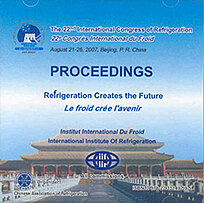
IIR document
CO2 cycle based on compression cooling.
Author(s) : TOUBLANC C., CLAUSSE M., TERRIER M. F., et al.
Summary
If direct greenhouse gas emissions are negligible with carbon dioxide as refrigerant, indirect emissions linked to overall system efficiency have to be as low as possible to be competitive with hydrofluorocarbons. Despite attractive thermophysical properties, the thermodynamic efficiency is quiet poor due to supercritical gas cooling. To achieve high performances, the authors propose a new cycle based on isothermal compression. They have explored different ways to get a near isothermal compression: external wall chamber cooling, internal atomised oil injection and finally multistage compression have been investigated. It appears that external cooling has nearly no effect for reciprocating compressors while oil injection allows increasing the overall efficiency by 30% depending on injection rate. Multistage intercooler compression is promising for large cooling rate, as the coefficient of performance enhances by 38% when using five compression stages. However, all possible combinations to cool carbon dioxide during compression have to be considered.
Available documents
Format PDF
Pages: ICR07-B1-122
Available
Public price
20 €
Member price*
Free
* Best rate depending on membership category (see the detailed benefits of individual and corporate memberships).
Details
- Original title: CO2 cycle based on compression cooling.
- Record ID : 2007-2034
- Languages: English
- Source: ICR 2007. Refrigeration Creates the Future. Proceedings of the 22nd IIR International Congress of Refrigeration.
- Publication date: 2007/08/21
Links
See other articles from the proceedings (839)
See the conference proceedings
Indexing
-
Themes:
Compressors;
CO2 - Keywords: Research; Compression system; Thermodynamic cycle; Refrigerant; Compression; CO2
-
Pointing to the future: two-stage CO2 compression.
- Author(s) : INAGAKI M., SASAYA H., OZAKLI Y.
- Date : 1997/11/06
- Languages : English
- Source: Heat Transfer Issues in Natural Refrigerants
- Formats : PDF
View record
-
Flooded compression in CO2 scroll compressors.
- Author(s) : BELL I., GROLL E., BRAUN J., et al.
- Date : 2010/04/12
- Languages : English
- Source: 9th IIR-Gustav Lorentzen Conference on Natural Working Fluids (GL2010). Proceedings. Sydney, Australia, April 12-14, 2010.
- Formats : PDF
View record
-
Performance of a transcritical CO2 heat pump fo...
- Author(s) : YARRALL M. G., WHITE S. D., CLELAND D. J., et al.
- Date : 1999/09/19
- Languages : English
- Source: 20th International Congress of Refrigeration: Refrigeration into the Third Millennium.
- Formats : PDF
View record
-
Using carbon dioxide in a transcritical vapour ...
- Author(s) : ROBINSON D. M., GROLL E. A.
- Date : 1996/07/23
- Languages : English
- Source: Proceedings of the 1996 Purdue International Refrigeration Conference.
View record
-
Investigation of transcritical R-744 Voorhees h...
- Author(s) : ZHA S., HAFNER A., NEKSÅ P.
- Date : 2006/05/29
- Languages : English
- Source: 7th IIR-Gustav Lorentzen Conference on Natural Working Fluids (GL2006). Proceedings
- Formats : PDF
View record
